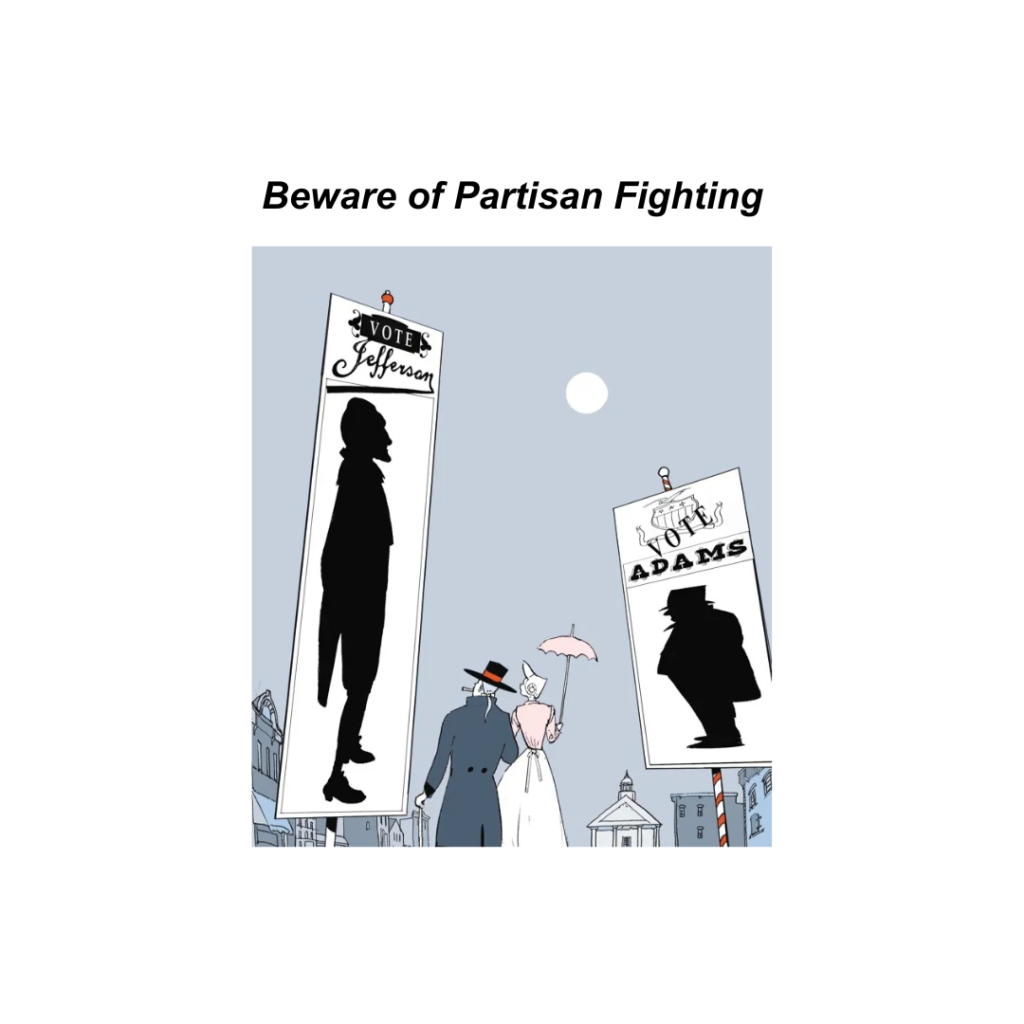“Let me now take a more comprehensive view, and warn you in the most solemn manner against the baneful effects of the spirit of party generally.” – George Washington
From the Election of 1800 to 2023, political divisions have transcended to household divisions. Despite George Washington’s warning in his farewell address of 1796, political parties made a steadfast home for themselves in the United States of America, continuing to be propelled by the same press and media that launched the Federalist Party and the Democratic-Republican Party during the Election of 1800.
The Early Days of Partisan Fighting
Our first political parties would clash against each other during the political revolution of the Election of 1800, marking the origins of our complicated political landscape. “Partisan newspapers for both sides took up the cause with sharply critical and even slanderous articles about the opposition.” The Philadelphia Aurora (Democratic-Republican) and Gazette of the United States (Federalist) were prominent examples of this, with early American newspapers unafraid to take sides. Events were also advertised to promote party ideals and the danger of opposition, with elections pitting the two repeatedly. By the decade’s end, each party “saw the other as a clear threat to the future of the US” (America in Class).
To this day, partisan fighting holds a prominent role in US politics. A New York Times article described, “A couple in Georgia … won’t speak when the husband leaves his unwashed mug supporting President Trump in the sink …. A teenager … had his “Make America Great Again” hat ripped off his head and a drink was thrown in his face. A mother in New England sought the help of professional conflict mediators … because her two daughters — one … pro-Trump, the other anti-Trump — had stopped speaking to each other” (Peters). Though the labels of the Federalist Party and the Democratic-Republican party have been outdated, criticizing others for their party affiliations remains in trend in society, if not heightened in popularity with the weaponization of digital press and media.
Regarding the ever-pertinent presence of partisan fighting, President Barack Obama dispelled his own thoughts concerning partisan fighting in his farewell address 221 years later:
“But that potential will only be realized if our democracy works. Only if our politics better reflects the decency of our people. Only if all of us, regardless of party affiliation or particular interests, help restore the sense of common purpose” – Barack Obama
Nevertheless, though farewell addresses from President George Washington to President Barack Obama have advised citizens to look past party affiliations and unite for the country, political parties may be necessary for our modern mass democracy. As political scientists like Lee Drutman have observed, political parties have the power to facilitate a healthy democracy by aggregating the long-term policy goals of diverse groups (Drutman).
For instance, during the Election of 1800, the Democratic-Republicans’ visible support for strong state governments and the strict interpretation of the Constitution differed from the Federalists, who advocated for a stronger federal government and a loose interpretation of the Constitution. Citizens saw themselves reflected in these long-term policy goals for the early nation and voted for the party they aligned with during the Election of 1800.
Fast forward 223 years, and even now, party affiliation is determined by citizens’ support of party ideals. While the Democrats have stated their support for gun control laws, the Republican party has defended their position on not enforcing such laws to protect the right to bear arms. Military spending, LGBTQ+ rights, abortion rights, and many more public issues join the stances these two parties often disagree upon. At this intense cornerstone of opposing viewpoints in a nation struggling to maintain political transparency, the citizens must be able to rely on their party affiliations to understand they are voting for the candidate with the same political ideals as them.
Thus, though political parties have been widely considered poorly performing and faced disapprovement from the time of our first president, Drutman and many others support the solution of creating more political parties, with more emphasis on communicating the consequences of policies, supporting qualified candidates, and assembling “governing majorities and broker compromises to solve public problems” among other steps to create a more healthy system.
It may seem peculiar that the current political scientists of today support the creation of new parties. However, considering how the existence of political parties has allowed citizens to vote for candidates working towards their shared long-term visions for the United States since 1800, parties may be the key to promoting new choices of candidates to voters with structure. Perhaps, instead of seeing the Democratic Party and the Republican Party as structures to dissolve, the solution is for citizens to focus more on the meaning behind those affiliations, which may be the key to uniting the nation for betterment.
Works Cited
“About Parties and Leadership | Historical Overview.” US Senate: About Parties and Leadership | Historical Overview, 7 Aug. 2023, www.senate.gov/about/origins-foundations/parties-leadership/overview.htm.
Casper, Scott. “The Revolution of 1800.” America in Class, 22 Sept. 2022, americainclass.org/the-revolution-of-1800/.
Drutman, Lee. “Opinion | Our Two-Party Political System Isn’t Working. The Fix? More Parties.” The Washington Post, WP Company, 5 July 2023, www.washingtonpost.com/opinions/2023/07/05/more-political-parties-democracy/.
Lepore, Jill. “Party Time.” The New Yorker, 10 Sept. 2007, www.newyorker.com/magazine/2007/09/17/party-time. P
eters, Jeremy W. “In a Divided Era, One Thing Seems to Unite: Political Anger.”
The New York Times, The New York Times, 17 Aug. 2018, www.nytimes.com/2018/08/17/us/politics/political-fights.html.
